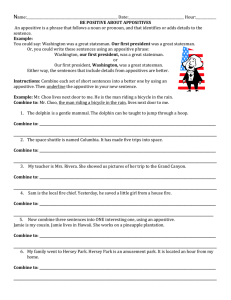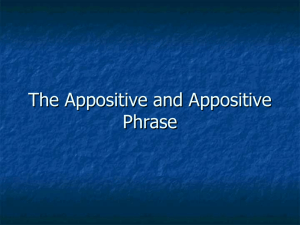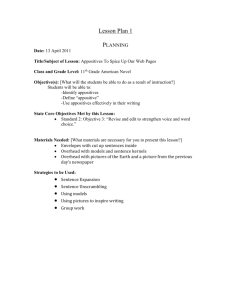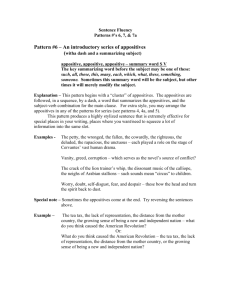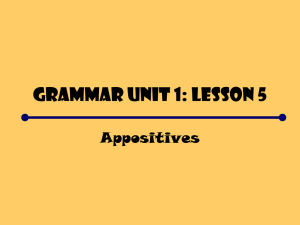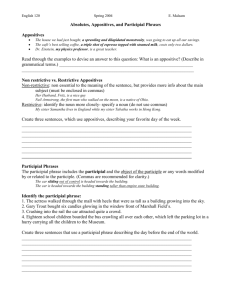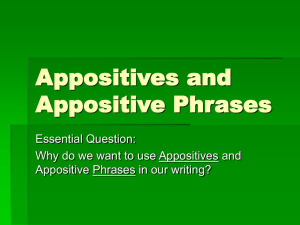A Definition PPOSITIVES
advertisement
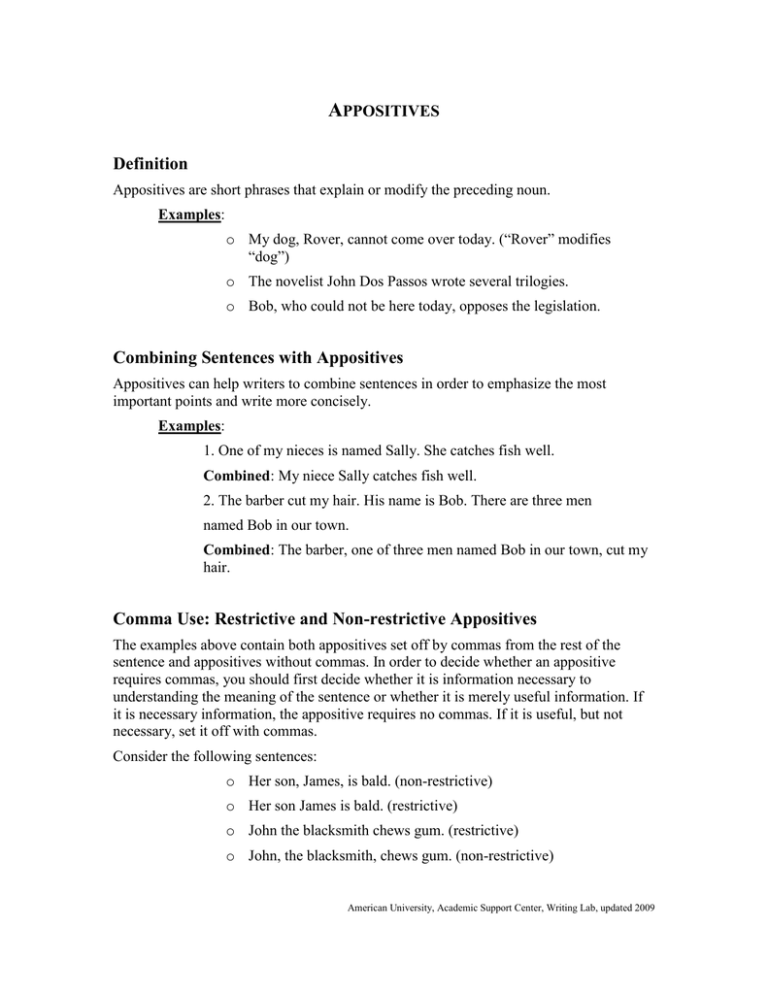
APPOSITIVES Definition Appositives are short phrases that explain or modify the preceding noun. Examples: o My dog, Rover, cannot come over today. (“Rover” modifies “dog”) o The novelist John Dos Passos wrote several trilogies. o Bob, who could not be here today, opposes the legislation. Combining Sentences with Appositives Appositives can help writers to combine sentences in order to emphasize the most important points and write more concisely. Examples: 1. One of my nieces is named Sally. She catches fish well. Combined: My niece Sally catches fish well. 2. The barber cut my hair. His name is Bob. There are three men named Bob in our town. Combined: The barber, one of three men named Bob in our town, cut my hair. Comma Use: Restrictive and Non-restrictive Appositives The examples above contain both appositives set off by commas from the rest of the sentence and appositives without commas. In order to decide whether an appositive requires commas, you should first decide whether it is information necessary to understanding the meaning of the sentence or whether it is merely useful information. If it is necessary information, the appositive requires no commas. If it is useful, but not necessary, set it off with commas. Consider the following sentences: o Her son, James, is bald. (non-restrictive) o Her son James is bald. (restrictive) o John the blacksmith chews gum. (restrictive) o John, the blacksmith, chews gum. (non-restrictive) American University, Academic Support Center, Writing Lab, updated 2009 In each example, the two sentences have different meanings. In the first example, the first sentence implies that the woman only has one son. The son’s name is a non-restrictive appositive because it is useful, but unnecessary information; the name does not modify its referent in a way that changes the meaning of the sentence. The sentence would have the same meaning without the appositive. The absent commas in the first example’s second sentence tell us that the woman has more than one son, and that the balding one is James. In this case, the son’s name is a restrictive appositive because it restricts the meaning of the noun. In the second example, the restrictive clause tells us that there is more than one John and that the one that is meant is the blacksmith. If there is only one John, the fact that he is a blacksmith is unnecessary, though still interesting, information. Exercises: A. Combine the following sentences using appositives: 1. Liam is my pet. He is a snake. He has only bitten one person. 2. Curling is a fun sport. It is played on ice with brooms and a large stone. 3. John Smith was absent today. He is the student with red hair. B. Decide whether the italicized appositive should be restrictive or non-restrictive, and correct the punctuation to reflect your choice: 1. My uncle John is my favorite uncle. 2. The name of the electronics company, Short’s Circuits, should be changed. 3. Students, who miss class three times, will lose ten points. 4. The book, found on the top shelf, was quite dusty. Exercise Answers: A: 1. Liam, my pet snake, has only bitten one person. 2. Curling, a sport played on ice with brooms and a large stone, is fun. 3. John Smith, the student with the red hair, was absent today. B: 1. My uncle John is my favorite uncle. 2. The name of the electronics company, Short's Circuits, should be changed. 3. Students who miss class three times will lose ten points. 4. The book found on the top shelf was quite dusty. American University, Academic Support Center, Writing Lab, updated 2009
